
Armen Spec: Yamaha RD400(LC) from Armen Manougian…
One of the bikes that stood out most to us at the 2024 Handbuilt Show was this stunning Yamaha RD400 from our new friend Armen Manougian — a veteran superbike racer and builder who’s operated Allstar Auto Center in Rancho Cucamonga (CA) for 25 years and campaigned bikes under the Allstar Racing banner in WSMC, WERA, and AFM competition. Little did we know that the story behind the build is just as incredible as the bike itself.
Unlike most café racers, this RD400 has true racing pedigree. The original owner of the bike, John Lau, has worked at Yoshimura for 40+ years and built the bike as a road racer, teaming up with a young rider named Wendell Phillips — the future owner of Lockhart-Phillips USA!
“The bike was raced at Willow Springs International Speedway and after losing interest they turned it into a canyon carver and would often take it up in the Los Angeles hills at the famed Mulholland canyon on the weekends.”
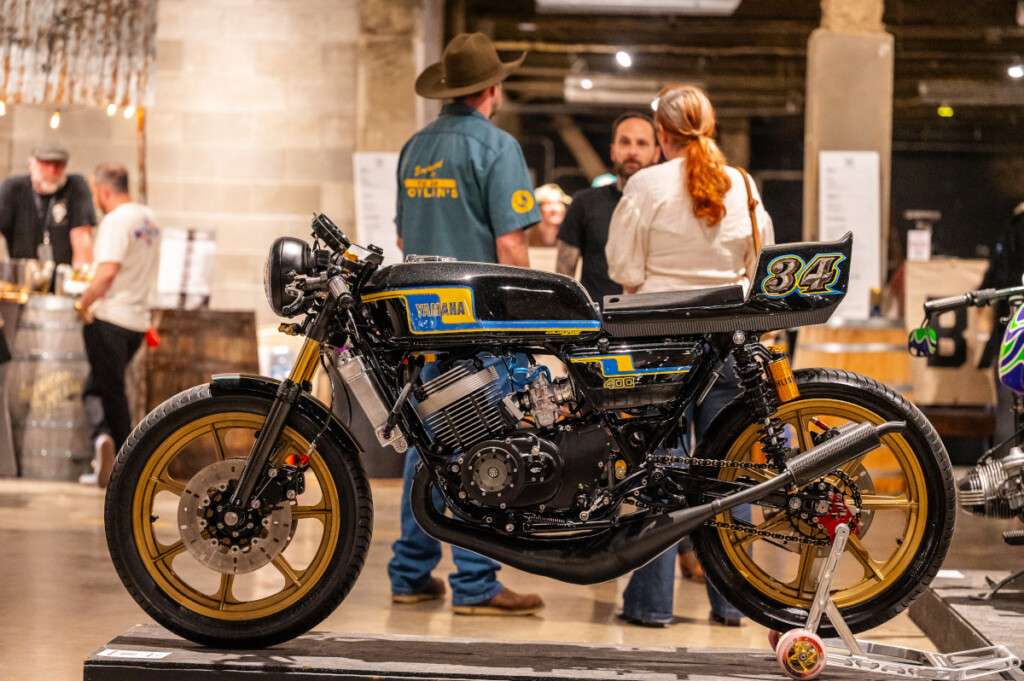
After its canyon carving days came to a close, the RD sat in John Lau’s garage largely untouched for 40 years until he asked his former roommate, Russ Norman, what he ought to do with it. Russ was heavily involved in road racing from the 1970-90s — a mentor to Armen and a lot of other riders over the years.
“The guy taught me a lot growing up in the motorcycle racing scene; he’s helped riders like Nick Ienatsh win his first championship racing, worked on the Kalguard race team with Wes Cooley, helped get Donald Jacks a ride at Suzuki, and has done work for Yoshimura and Motul.” -Armen
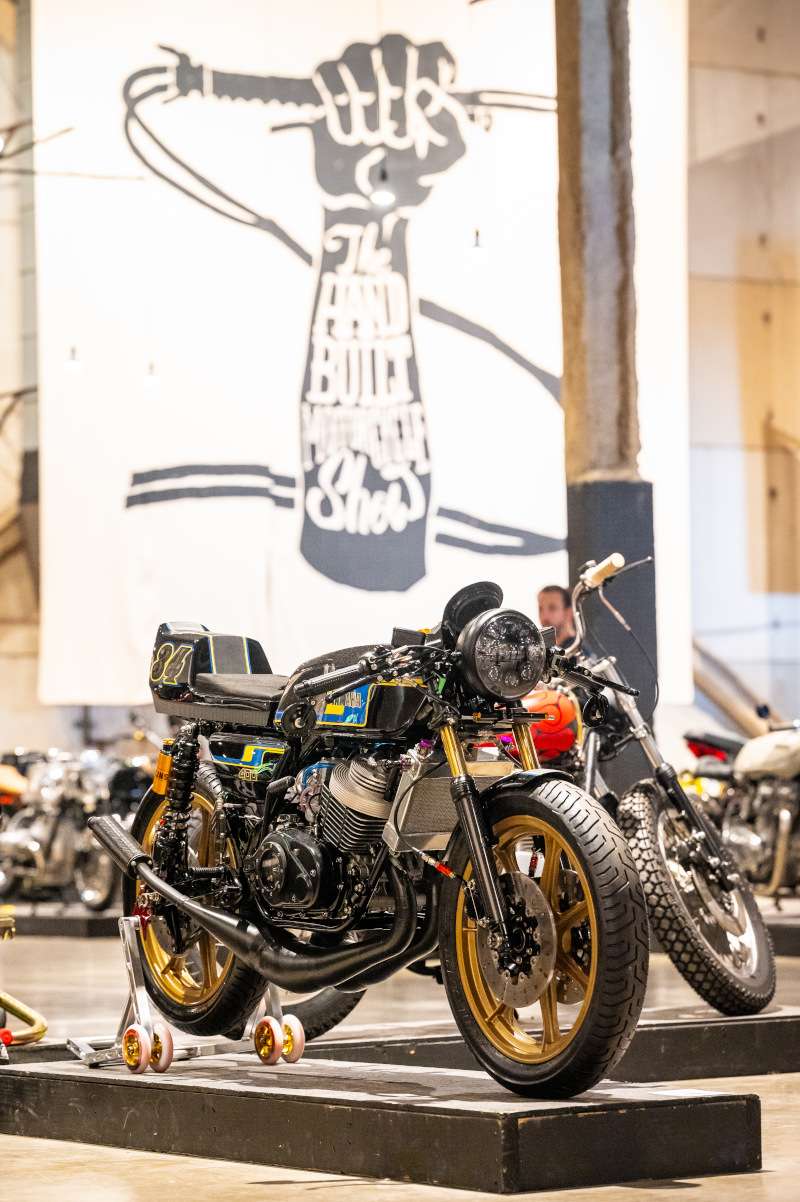
Russ knew exactly what to do with John’s old RD400, knowing that Armen had always wanted to build a vintage cafe racer.
“I think we should give it to Armen, he’ll do some crazy stuff to it.”
It took Armen a few years to get started on the project, but once he did, he went all out with the obsession and attention to detail he’s known for in racing circles — traits that earned the name “A SPEC” (Armen Spec) in the inspection line at Willow Springs.
“My vision for the bike was to implement modern tech, race track pedigree, and classic style into a bike that would catch the essence of the classic RD400 look but with a modern technologically advanced improvements found on current racing machines.”
Armen delves deep into the modifications below, but a few highlights include the ultra-rare water-cooled Revco heads (!), Morris Mag wheels, swingarm designed in collaboration with fabricator Mark Atkinson of Speed of Cheese Racing, braced / gusseted / straightened frame, dual front brakes, MotoGP/Superbike Brembo master cylinders, engine fully rebuilt with VForce4 carbon reeds and Mikuni flat-slide carbs, modified Jim Lomas chambers, Motogadget electronics, a Holeshot electronic quickshifter, and much, much more!
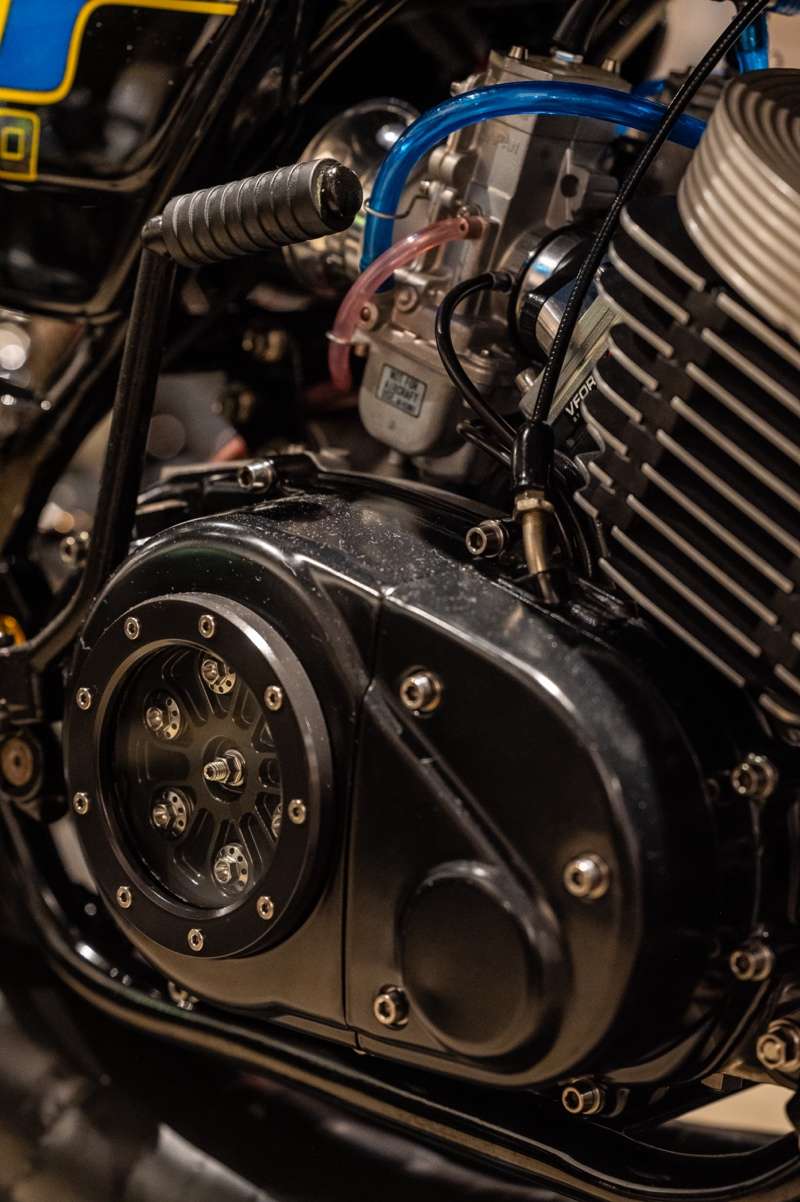
The Yoshimura blue is Armen’s racing color, while the Dakar yellow is a nod to Speed of Cheese Racing, and “A-SPEC” is ghosted into the side covers — the paint laid down by Matt Polosky of Color Zone Designs.
Throughout the years, Russ had stayed after Armen to complete the build, and he got to see the A-SPEC RD400 take home a well-deserved Best of Show at the annual 2 Stroke Extravaganza.
“Sadly Russ past away just 80 days after the show. Russ was a hard head and the last guy to show any emotion or give a compliment — it felt like a million bucks when he said the bike I built was awesome, the best RD400 he’d ever seen. This is why I dedicate this build solely to him.”

What an incredible tribute to a friend and mentor — we’re so happy Russ got to see this two-stroke fire up before his passing and attract the attention it rightly deserves. Armen, kudos for transforming this old racer and canyon carver into the most incredible RD400 cafe racer we’ve ever seen — we know Russ is proud.
Below, Armen takes us through every step of the build, singling out all the folks who helped him along the way. Enjoy!A-SPEC RD400: In the Builder’s Words…
The bike was originally owned by John Lau who is the distribution manger at Yoshimura and has worked there for over 40 years! John had built the bike to road race and teamed up with a young rider named Wendell Phillips (future owner of Lockhart Phillips USA). The bike was raced at Willow Springs International Speedway and after losing interest they turned it into a canyon carver and would often take it up in the Los Angeles hills at the famed Mulholland canyon on the weekends.
In 2016 John asked his former roommate and good friend Russ Norman what he should do with the RD400 sitting in his garage for 40 years since he was moving into a smaller place? Russ at the time was knee-deep in two ultra custom motorcycle builds himself, but he immediately said: “I think we should give it to Armen, he’ll do some crazy stuff to it.” He knew I’ve always wanted to build an older bike.
When I first acquired it I was going through a divorce so it kinda sat in the back of my shop for five years plus I was also racing at the time. I’ve owned my own auto repair shop in the city of Rancho Cucamonga, California called Allstar Auto Center for 25 years now. Two of the bays are specifically reserved for the bikes. Throughout the years we’ve built some amazing race bikes, mainly superbikes under the Allstar Racing banner. We’ve raced local expert and pro club level road races with WSMC, WERA, and AFM. On any day our customers could walk in our shop and see everything from factory-kitted Yoshimura Suzuki superbikes to a one-off Ducati Superleggera Superbike built for racing.
Acquiring this RD400 was ironic, because I always wanted to build a classic “cafe racer” but couldn’t decide what to build. But when Russ called me and said “you wanna put your razzle-dazzle on this?” I took him up on the offer and made that decision easy, especially since they gifted it to me!
After five years and Russ pushing me to get started on it, I finally dragged it out, wiped the cobwebs off it, and went to work stripping it down to the bare frame.
My vision for the bike was to implement modern tech, race track pedigree, and classic style into a bike that would catch the essence of the classic RD400 look but with a modern technologically advanced improvements found on current racing machines.

Upon examining the bike closely I noticed the heads were different. Russ had told me John had spent a fortune back in the day on ultra-rare water-cooled heads made by Revco. These heads simply replaced stock heads and came with a tiny radiator, and the coolant flows by a process called thermo-siphon so there’s no need for a pump. Also I noticed the rear wheel was a very rare 18” Morris Mag wheel, while the front was a stock alloy Yamaha wheel.
First thing was deciding suspension. I opted with traditional RD400 forks; I didn’t want to install larger more modern forks for several reasons. First the bike is tiny so even R6 forks seem large, second it took away too much of the original look, and finally the forks are 34mm — I couldn’t say no to 34 as it’s my racing number! I’ve seen far too many builds with overly beefed-up suspension.
A lot of details went into the the forks. I machined the dampening rod to install a gold valve emulator from Racetech, machined a custom adjustable shim stack for preload, and Mark Atkinson of Speed of Cheese Racing in Utah made the air-charged fork caps!
As for the rear suspension I contacted Mike Wheeler at Kyle Racing USA to come up with a set of Öhlins rear shocks that would work with the RD. So he put together a kit modified from another bike and made them work perfectly.
If you look closely you can notice the custom triple clamps made by Cognito Moto are set back 10mm making the fork to stem offset 35mm, not 45mm as on a stock RD. Look even closer and you can see the steering dampener arm that holds the Öhlins dampener under the headlight like a modern bike. Away with the hideously long side-mounted dampener found on older bikes!
The next part was the short and heavy steel swingarm along with that disgusting stock rear brake caliper bracket. I reached out to Mark Atkinson again — Mark is a unique individual in the custom machining world. He actually knows a lot about motorcycle tech, along with racing, along with engine building, along with custom fabrication, and oh did I mention he’s fast and affordable? He has worked on cars and bikes that have won the biggest shows. It was an honor to work with him on this project. I paid homage to him and Speed of Cheese racing by adding Dakar yellow (his racing color is BMW Dakar yellow) to my paint scheme, and that’s where you get the name Speed of Cheese Racing.
Mark and I went back and forth designing a swingarm and brake bracket 800 miles apart from each other. We made the swingarm two inches longer and I also had Mark machine all the axles out of titanium using custom Ti flange nuts, even the captive collar for the rear brake bracket was machined out of titanium!
Once the swingarm was fitted we noticed the swingarm pivot angle was 14° and after careful discussing with an old expert racer and bike guru Marc Rittner, we decided that we should use an 11° swing arm pivot angle to make the bike handle perfectly.
Russ and I had initially thought of a great idea that we use on modern superbikes and that was making an adjustable swingarm pivot. It would involve cutting the pivot bracket off and designing and machining one then take it to the frame shop and jig it all up. I gave Mark a basic drawing of what I wanted and he turned it into a CAD (computer animated drawing) and within 2-3 days it was being machined! As soon as I got the freshly machined parts I cut the stock pivot off and prepped the frame for Dr. John’s frame shop.
Prior to sending it Dr. John’s I’d gusseted the entire frame, boxed in the main joint, and also welded a frame mount for the dampener — I had removed the steering head lock as well to give it a more cleaner look. Then removed mounts for battery box and made way for the seat pan, which acts as a coolant reservoir.
Doctor John’s got the frame perfectly straight and center with the new swingarm. You can see the gold anodized piece can be rotated 180° to drastically change the pivot point, or you can replace it with other pieces with different offsets that I had Mark machine.
During all the frame and prep work I also had the engine completely torn apart. First thing was to gut the entire engine and send all cylinders, pistons, heads, and cranks to Scott Clough of Scott Clough Racing. Scott is a legendary former Southern California road racer and RD engine specialist.
He ported the cylinders and reed cage to house VForce4 carbon reeds. He honed up the cylinders, got a new set of pistons, and built the crank using ceramic bearings. While he was working away I spent an entire day vapor-honing the cases and ordering all the titanium fasteners for the engine, even the custom studs and custom female head bolts that Mark had machined out of titanium.
When I received the engine parts I vapor-honed the heads and sent them to Yoshimura to have Kenny Kato throw it in their polishing tumbler to give it a smooth polished look before sending it out to get hard anodized, giving it the original look of the Revco heads.
I sent everything else out to Cryo Heat to have every single internal engine and transmission part polished and cryogenically treated making for adding durability, smoother shifts, and extra horsepower from less drag. When all the internals were assembled, I had a good friend of Russ in town, Gus Christensen, all the way from North Carolina working on Russ’s YZR500 replica at my shop. I said why not have him assemble it since he knows everything about these engines. Gus not only assembled the engine to perfection he also help weld together the custom seat pan/coolant reservoir and also the battery tray.
When it came to cooling, I was lucky enough to have a local radiator shop who’s a local veteran dirt tracker, Jeff at Fontana Radiator. He knows everyone in dirt tracking and has built radiators for legends and current racers. I had him make a custom radiator small enough to fit but large enough to properly cool. I had him weld in some Wiggins clamshell bungs for the lines and vents to use Wiggins hose clamps with some nice pressure AN fittings. Then I simply made a stainless steel radiator guard to give it some protection.
Now that the engine was built, induction was the next step — I ordered a set of custom machined manifolds by Chariot and also a pair of 32mm Mikuni flat-slide carburetors from HVC Cycle. I had a throttle cable assembly from my Suzuki race bikes that had really trick machined aluminum tubing, and I had a local So Cal cable shop, Flanders, make exact fit cables for the throttles.
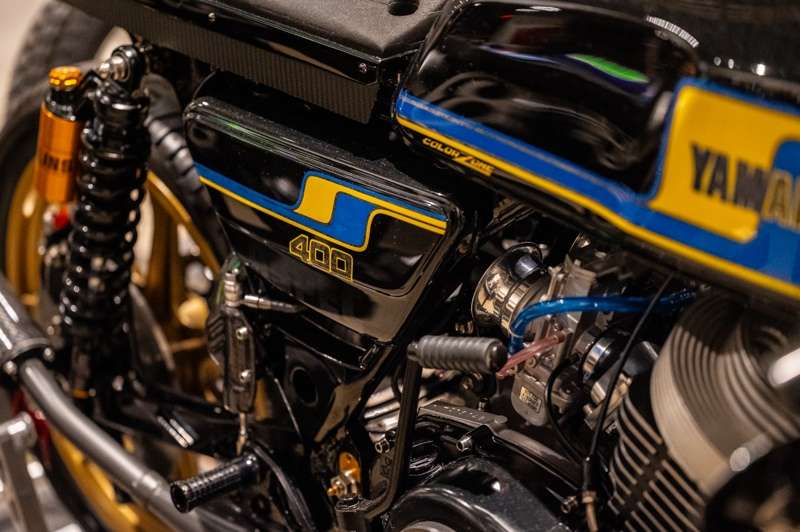
The three piece billet clutch is made by Hinson. I’d also custom-machined a clutch pusher to utilize a flat bearing so I can make a final clutch adjustment just like on a Yamaha Banshee, just in case I were to ever make a hydraulic clutch for the bike (which was in the back of my mind the entire build).
The exhaust was made by JL Exhausts; however, I had Mark CNC machine new spigots and flanges that matched the larger exhaust porting and also retain a nice thicker o-ring that doesn’t tear easy. When I received the flanges I sent them to Yoshimura to have their main exhaust guy Juan Lizama weld them up perfectly — I also had him reduce the size of the mufflers 2.5” for aesthetic reasons.
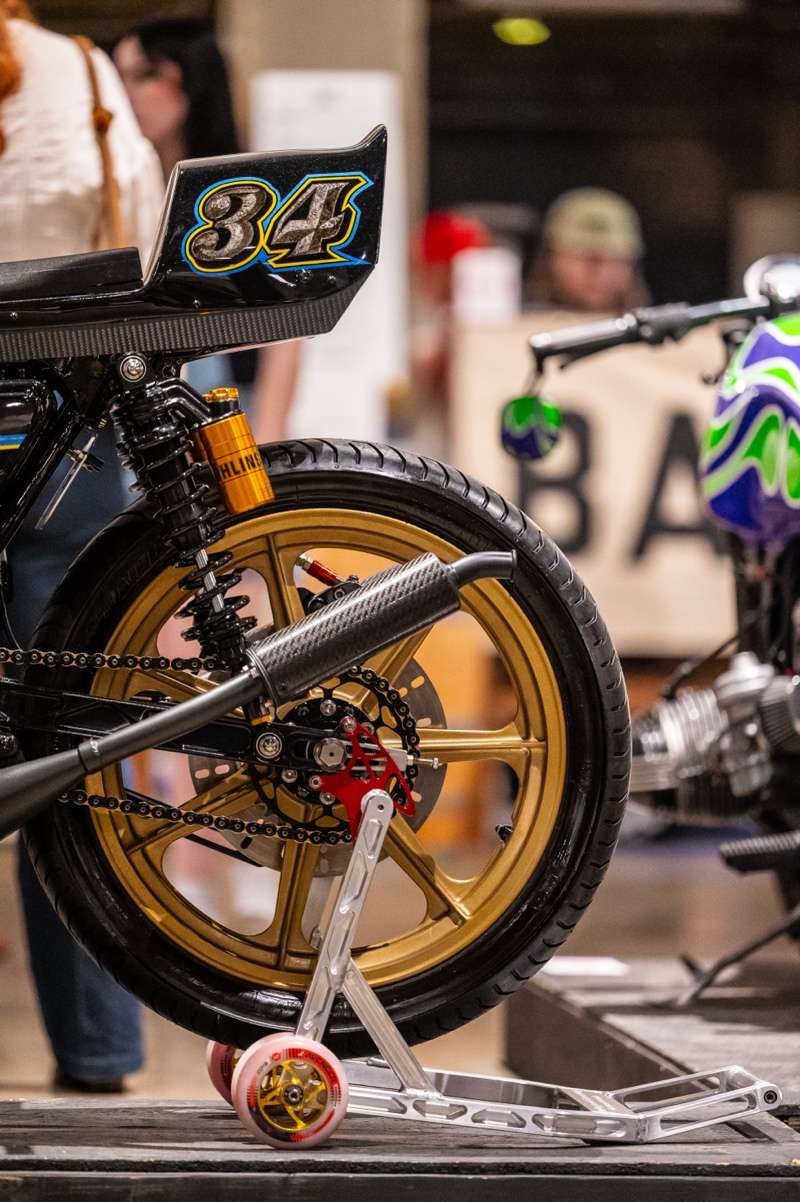
The fuel tank was modified to dual petcock valves, not just any valves but two high flow Pingel valves. The crossover pipe was eliminated (for easy tank removal) with some 3/8” bungs and plugs. The fuel lines were arranged in a double “T” with Tygon Tubing, so in any lean angle both carbs would always have fuel from either side.
When it came to brakes I had a brand new $2300 MotoGp/Superbike Brembo master cylinder laying around and probably would have used it on another bike, but I was like hmmmmm…that would look nice. Needless to say I slapped it on as a joke and was like well that looks sick! So I went with it. I later ordered a Motocorse fixed reservoir, which gave it a clean look with no feed hoses or a plastic reservoir tank.
RD400’s utilize a single front brake on the front right hand side. I noticed the upper brake caliper mounting hole on the RD400 fork was elongated, so I went on eBay to look at pictures of fork legs for sale and over half the ones listed for sale had the holes elongated — it must be from too much stress and wear on that one caliper. That’s when I decided I should go dual brakes.
Everyone online always says “you don’t it need the added weight, the brakes are fine.” My response was: “Well, genius, since I shaved 102 pounds off the bike even with the dual brakes, I think I’m good.” Plus it looks symmetrical.
At first I got a set of forks and cut the bungs off and welded them on the existing left fork. It was okay but I wasn’t happy with it, it just looked like it was a temporary and not show quality. So after looking online for days I realized an RD350 the brake caliper is on the right side in front of the fork and if I were to rotate that fork to the left side, the brake caliper would on the backside of the fork just like on the 400.
There still were some issues. The 350 uses a narrower outer dust seal, but the forks look like they were casted out of the same casting and both use 34mm tubes and even the same inner seal. So on my milling machine I set up the right RD400 fork leg on a horizontal rotary table and tail stock and just machined the top lip where the dust seal mounts on. I also machined a groove for the seal catch just like the 350 side, so now they both use matching RD350 dust seals.
The other issue was the reverse side brake line mount, which I didn’t need, so I machined them off on both sides giving a cleaner look. Since I was opting for dual brakes I needed to machine the inside of the fork flat just like the right side to clear the rotors and the buttons for the floaters. In fact I had to take an additional 2mm on the right side as well for clearance. Also, the left side fork no longer had a bottom clamp axle cap, so I had to machine a new axle which Mark was gonna make out of titanium anyway. The last touch was powder coating the fork bottoms and installing a carbon fiber fork guard I’d made.
As far as the brake calipers went I left them stock; I honestly liked the way they looked except for the huge M12 mounting bolts that convert to M10 on the fork mounts. I simply used a TIME-SERT to convert the threads to M10 and pressed 12mm titanium tubing to line the inside of the calipers holes so it would not give stress to the bolts, This made all the caliper bolts match, and I used titanium hardware drilled for safety wire, EBC floating rotors, custom brake lines using Goodridge stainless fittings, and titanium banjo bolts and bleeders. I also installed a set of Staubli dry break brake line adapters just like a modern racing machine would require. In the rear a standard Brembo rear master cylinder with the stock caliper and matching EBC floating rotor just like the front with a Staubli dry break adapter.
When I got the bike it only had a rear Morris mag wheel. I desperately wanted a matching front wheel and looked for weeks. Russ had gone over to his friend Howard Monise’s house — a long time friend and experienced 2 stroke builder — and one Saturday Russ just showed up to my shop and said here ya go got one…like it was nothing. I was like okay great!
After sending out the wheels to Sam at Young Gun Coatings and getting them coated in Spanish Gold, I ordered ceramic wheel bearings from Worldwide Bearings — they’re the leading supplier for bearings for all the racing teams. With the wheels I had to have Mark at Speed of Cheese Racing make some hub spacers to fit the offset of the rotors, and we also opted for larger ID diameter of the bearings up front as I do all my race bikes so we can press captive wheel spacers so the spacers don’t fall off when changing wheels.
The attention to detail that Mark put into every part is awesome. I even trimmed up the fiberglass race front fender and drew up an idea for fender mounts so Mark machined some trick fender mounts that are almost hidden. The fender mount holes on the forks protruded out too much and since we were adding 5mm thick fender mounts I needed to machine these down to be flush with the fork tubes; this gave me the clearance necessary to use the new fender mounts. Yamaha uses M8 bolts to mount a steel fender onto the forks. Since our fender was light I installed TIME-SERTS and converted the threads to M6 making the bolts not so redundant, and of course we opted for titanium fasteners.
When it came to gearing, when I first started the build I naively ordered som sprockets for the Morris mag wheels from Sprocket Specialists. They looked great but I soon realized I would need something custom not off the shelf. I contacted Mark and he came up with two designs and we made several sprockets for different gearing and for spares. Mark also came up with a neat design for the rear sprocket hub.
When I found out about Motogadget and their M-unit Blue it was a big WTF moment for me. Needless to say I got rid of all the NOS electronics I had just bought. The M-unit simplified my electronics, added keyless on/off, reduced weight and size of the harness, and gave it high tech app, alarm, and cell phone connectivity.
On the custom harness itself I used Deutsche connectors and gold terminals all wrapped up in expandable basketweave sleeves for a clean look. Devin at Cognito Moto helped answer all my wire harness questions since the RD400 was kickstart it was gonna be slightly different.
Cognito Moto also has to be mentioned for their beautiful tach/speedo setup. It has all the features, turn signal/high-beam display, large tach or speedo layout (I went with the large tach display). You can even tell your 0-60 times and no need for speedo cable because it runs off GPS, and the tach cable? Kiss it goodbye because now it’s wired directly into the Vape Racing ignition system supplied by HVC Cycle.
The dash display can be controlled by the yellow button on the left MotoGP-style billet handlebar switch custom made for my application. I made a simple carbon fiber dash housing to add a little carbon fiber to the overall look. The adaptive headlight is by Motodemic along with the compact headlight bucket. The headlight lights farther up the road in turns when you lean. As you lean more the more lights light up to the side of the road. Really neat design and compact, looks aggressive as well. Turn signals are made by Motogadget and they are micro in size. It’s hard to believe the rears are tail/ brake/turn signal all in one.
The final electronic piece was something that took me back to the 90s. Back in the day if you had a race bike with a quickshifter it was like alien technology, but now they come standard on most liter bikes. I remember in 1997 I ordered a Dale Walker’s Holeshot 2 quickshifter for my GSXR. All my friends hated me. The easy shift during a wheelie or a seamless quick shift in mid corner in turn 2 at Willow Springs, it didn’t matter where it was, it was an advantage and I wanted to utilize it in this machine. So a quick Google search and I got a hold of Dale.
Luckily he’s still in business and still has some left. Although we ran into a hiccup at first due to the fact that a four stroke kills the ignition by opening the circuit, a two stroke kills the ignition by grounding it. Luckily Dale had one configured at the ready and shipped one out. Although I had to tell him I didn’t want the radio shack-looking shift sensor or the Atari-looking bypass toggle switch.
I opted for a modern FlashTune shift sensor and incorporated the bypass kill switch into my handlebar switch (white button). Now with this installed I can adjust the kill time to make quick shifts that not only shift gears quickly but you don’t have the RPM drop between shifts, which results in substantially quicker acceleration by staying in the power band — critical on a 2-stroke.
Some special notable one-off parts machined by Mark @ Speed of Cheese were the two-piece CNC machined kickstand, which is mounted to the frame into some bungs that could of been cut out of steel rod but no… Mark had some weld-on bungs CNC machined to fit perfectly on the RD frame so I could weld them in.
The rearsets are a really neat design — they don’t look like the generic rearsets mass produced in China. Mark put a lot of time into the design to make them both functional and look stunning. The oil tank was modified on the inside to make way for the seat pan / coolant reservoir, which eliminated the fill hole.
Since we needed to add a fill hole, we made the fill hole and dipstick in one. Mark and I came up with a design for a dipstick after welding an M18 threaded bung to the oil tank. Dipstick has a unique aluminum machined head design with a titanium dipstick!
Along with every fastener and axle being titanium, the only thing threaded on the entire bike that’s steel are the two transmission shafts. Even simple things like the rear brake clevis and rod are titanium. Titanium not only looks great, it’s lightweight and in most cases stronger.
Once everything was sorted out it came down to paint and body. I looked high and low for the right tail section. In the end I was going to make one, but after looking at the one that came on the bike I just simply decided to keep it. I got rid of the leather old school seat padding and cover and made one using race seat padding like I have on all my current race bikes. I cut it and shaped it filing and sanding until I got the result I wanted.
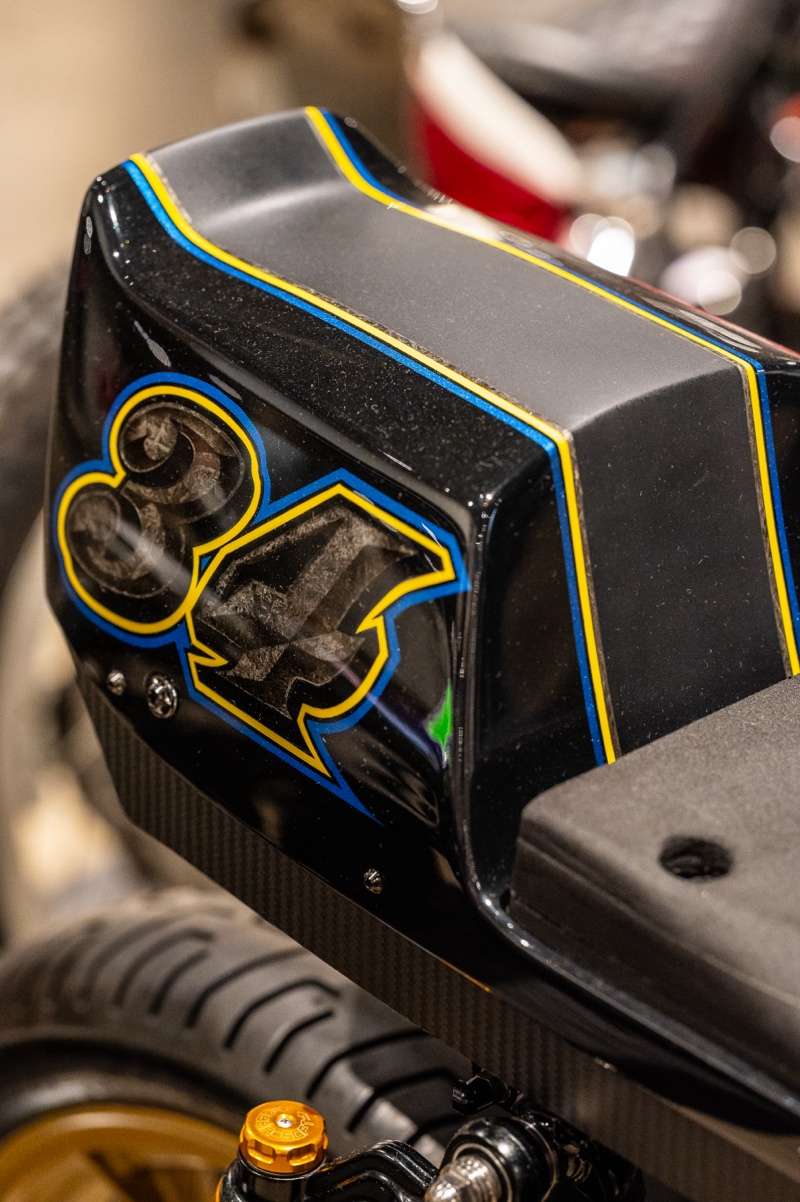
As far as paint design, I wanted to pay homage to the original Yamaha paint design, but I didn’t want it to look like every other perfectly restored RD400. I contacted Matt Polosky of Color Zone Designs — he’s the factory Yamaha race team and former Yoshimura racing painter, along with 100’s of amazing custom bikes and helmets he’s painted. We went with the stock design but changed the colors. Yoshimura racing blue (my race team colors) and Dakar yellow (Mark’s race color) — between all the work we both put into it, I thought it was quite fitting.
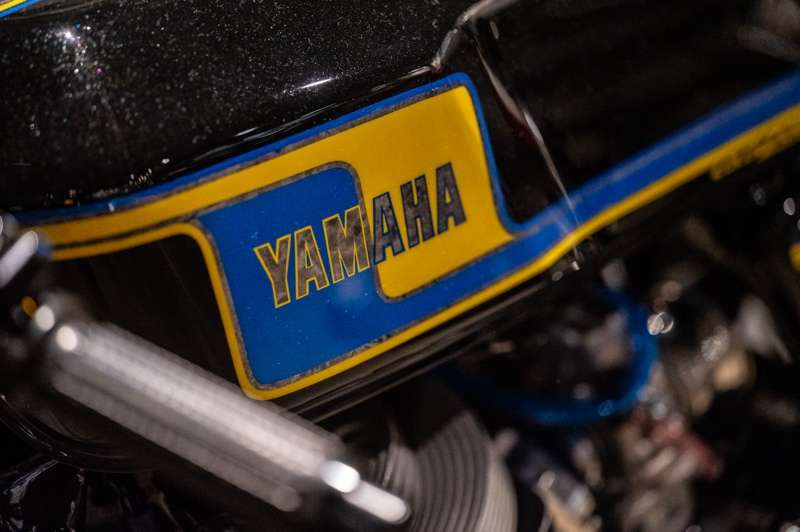
The main color being black was just something you don’t see too much of on RD’s. We also did the top flat black with my racing number 34. If you shine a light closely on the side pods and you he rear you can see the the ghost lettering A SPEC which stands for “Armen Spec.” Which was a term coined because of my obsession and attention to detail about my bikes in the tech inspection line at WSMC (Willow Springs Motorcycle Club). Glad I chose Matt at Color Zone — when it comes to paint design I get lost and his creativity certainly paid off in the end.
When the bike was finally done I wanted to do the hydraulic clutch conversion now that I could also confirm from OPPracing.com the matching…gulp…$2000 Brembo MotoGP clutch master could incorporate a matching Motocorse billet reservoir just like other brake master side.
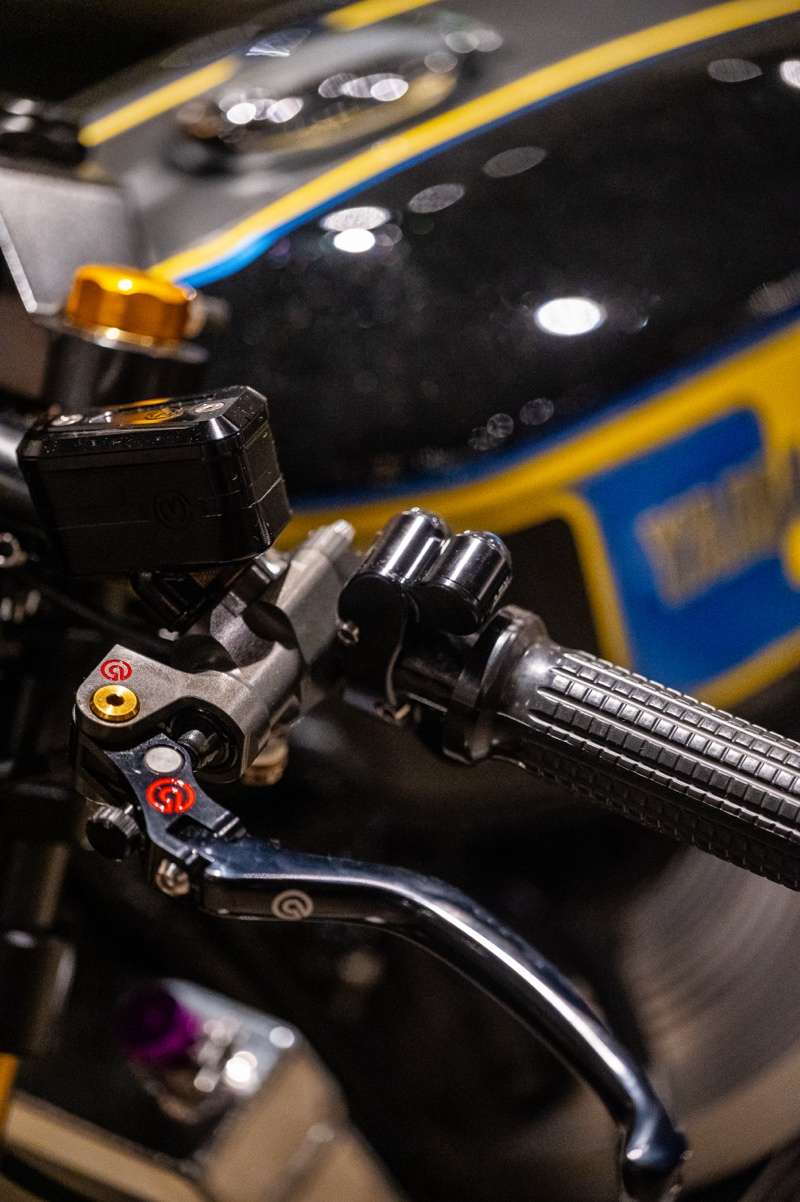
I had Mark scan a Ducati clutch slave cylinder’s mounting points and also the side cover mounting points where the clutch cable actuator is and come up with a mount I could bolt in the existing cover. Within two days he designed and made the part along with a clutch rod extension.
The item quickly bolted up and works perfectly and the clutch feel is probably 75% softer than when it had a clutch cable, which was needed due to the Hinson clutch adding a pair of extra plates and stiffer springs.
The final piece was the rear stand. As we were coming to an end, I told Mark we can’t let this build sit on an off the wall rear stand when put on display. I gave him a basic idea of what I had in mind, also utilizing needle bearings in the spools so they rotate not scratching the custom made lift points during a lift.
Along with some titanium fasteners and some trick rollerblade wheels with billet hubs, finalizing it with an inscription on the top of the stand that stays “Built by Speed of Cheese Racing for Armen Manougian”.
During the entire process of this build my friend and motorcycle mentor for nearly 30 years, Russ Norman, was constantly rushing me to get this project started, as a joke saying “hurry up before I die.” Little did we all know he was terminally ill, struggling with bone cancer and no one knew. A lot of his ideas we both shared went into this build, hell it was his idea to give it to me as a project.
Russ was involved in road racing in the ’70s, ’80s, even until the early ’90s. When I was in my early 20’s he introduced me to everyone in the racing industry to the point where I was testing race products for a company and getting parts and help from a lot of people for my racing. Russ was always at the track with another new video camera to record my races. In the end he just wanted to hear that 2-stoke fire up.
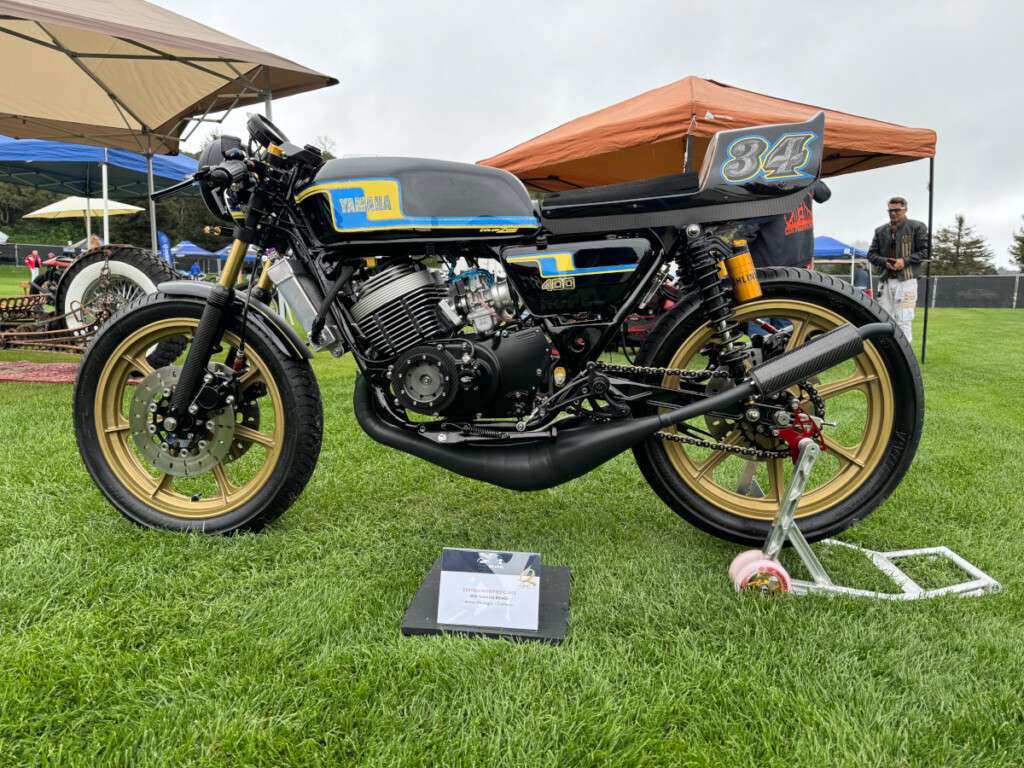
We took the bike to the 2 Stroke Extravaganza bike show in Southern California just before he got really sick. The bike won best of show and drew a lot of attention. Sadly Russ past away just 80 days after the show. Russ was a hard head and the last guy to show any emotion or give a compliment — it felt like a million bucks when he said the bike I built was awesome, the best RD400 he’d ever seen. This is why I dedicate this build solely to him.
Special thanks to everyone who helped and contributed to this bike build, it couldn’t have be done without you. Thanks to my girlfriend Kamila for all the lonely nights working at the shop until the sun came up.
Builder Thanks
- Russ Norman
- Mark Atkinson (Speed of Cheese Racing)
- Scott Clough Racing
- Gus Christensen
- John Lau
- Juan Lizama
- Matt Polosky (Color Zone Designs)
- Jeff (Fontana Radiator)
- Marc Ritner
- Howard Monise
- Doug Wells
- Devin/John (Cognito Moto)
- Dr. John’s Frame
- HVC Cycle
- Cryo Heat
- Motodemic
































































The amount of detail work on this? Bloody incredible. I only wish I were as talented. To all involved: You did yourselves proud. Love this!
Perfect job. Hat down.
Stavo facendo colazione davanti alla mia tazza di caffè e mi sono imbattuto nella tua moto, adesso la giornata è più interessante…
Great, highly detailed article on an amazing build. Having owned a new ’74 RD350, I can attest to the exhilaration you get from riding these brilliant 2-stroke middleweights. This is definitely a dream bike.